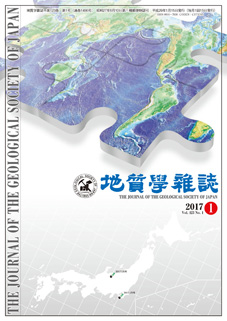
- |<
- <
- 1
- >
- >|
-
Akihiko Kikuchi, Takeshi Hasegawa2020Volume 126Issue 6 Pages 293-310
Published: June 15, 2020
Released on J-STAGE: October 14, 2020
JOURNAL FREE ACCESSThe Yosasagawa Debris Avalanche (YDA) is the oldest and largest debris avalanche associated with sector collapse of the Nasu Volcanic Group, North Tochigi Prefecture, Japan, during the middle Pleistocene. The deposit is widely distributed along the rivers that cut the Nasu Volcanic Group, such as the Yosasagwa and Naka rivers. Here, we report an investigation of the relative age, distal correlation, and depositional processes associated with the YDA. The YDA is characterized by the presence of matrix and block facies containing quartz-bearing pyroxene andesite to dacite (SiO2 = 58-63 wt.%) lava blocks and clasts that occur stratigraphically between widespread biotite-bearing tephras, such as KMT (Kaishio Kamitakara Tephra, 0.62 Ma) and APm (Ohamachi APm tephra, 0.36-0.33 Ma), in the Chubu region (Central Japan). Although previous research has reported the age of the YDA as 0.3 Ma, the tephra-based stratigraphy suggests that the YDA occurred before 0.36-0.33 Ma. Using lithofacies (debris avalanche-like), petrography, and the whole-rock geochemistry of lava blocks in the deposit, the YDA can be correlated with the Awakawa Pumice Bed in northern Ibaraki Prefecture. Based on this correlation, the runout distance can be estimated to be more than 100 km from the source, Sanbonyaridake Volcano, Nasu Volcanic Group. Although the lithofacies of the upper part of the YDA are uniquely massive and contain mega-blocks at all outcrops, the lithofacies in the lower part of the YDA show remarkable lateral variation; i.e., an increasingly proportion of lava blocks with clast-supported structure is observed downstream. This indicates that the YDA was water-saturated and fluidized by river transport and thus able to travel large distances as lahar.
View full abstractDownload PDF (5759K) -
Tsutomu Nakazawa, Ikuo Cho, Kentaro Sakata2020Volume 126Issue 6 Pages 311-326
Published: June 15, 2020
Released on J-STAGE: October 14, 2020
JOURNAL FREE ACCESSWe examined the influence of volcanic ash soil (loam beds) overlying fluvial terraces on ground motion characteristics in the Utsunomiya area, Tochigi Prefecture, central Japan. Microtremor surveys reveal that the loam beds exhibit relatively low S-wave velocities (130-150 m/s) and that the average S-wave velocities to the depth of 30 m (AVS30) and the peak frequencies of horizontal-to-vertical (H/V) spectral ratios become lower in higher terraces, due to the influence of thick loam beds overlying the gravelly terrace deposits. In addition, high AVS30 values and high peak frequencies of H/V spectra are observed in the lowlands along rivers, because these areas are underlain mainly by fluvial gravelly deposits without loam beds. Ground motions in a relatively low frequency range (e.g., 1.5-2.0 Hz) are more amplified on higher terraces and hills than on lower terraces or lowlands.
View full abstractDownload PDF (7114K)
-
Kazuhiro Suzuki, Seiji Hayashi, Koichi Mimura2020Volume 126Issue 6 Pages 327-332
Published: June 15, 2020
Released on J-STAGE: October 14, 2020
JOURNAL FREE ACCESSThe Takisawa limestone body is embedded in the Iinoya Formation of the Chichibu Composite Belt, central Japan. The geological age of the Takisawa limestone body is ambiguous due to a paucity of index fossils. Here, we collected ten samples of the Takisawa limestone and report two fragments of conodont P1 elements. These conodonts can be identified as Primatella sp. and Kraussodontus sp., which indicate a late Carnian to early Norian age (Late Triassic). Our newly reported conodonts demonstrate that the Takisawa limestone body is Late Triassic in age.
View full abstractDownload PDF (1747K) -
Mitsuhiro Nagata, Yoshikazu Kouchi, Shigeru Otoh2020Volume 126Issue 6 Pages 333-339
Published: June 15, 2020
Released on J-STAGE: October 14, 2020
JOURNAL FREE ACCESSThe Kabashima Granite has intruded the pre-Cretaceous geological unit in Kabashima Island near the southern tip of the Nomo (Nagasaki) Peninsula, Nagasaki Prefecture, western Kyushu, Japan. Although previous studies have reported Late Cretaceous (ca. 93-77 Ma) muscovite and biotite K-Ar dates from this granite body, we obtained only Early Cretaceous (ca. 125-110 Ma) zircon U-Pb dates; the dates were calculated from all the 206Pb/238U and 207Pb/235U data sets with the error-ellipse (2σ) intersecting the concordia curve on the concordia diagram. The difference between the muscovite and biotite K-Ar and zircon U-Pb dates is between 25 million and 40 million years.
View full abstractDownload PDF (5806K)
- |<
- <
- 1
- >
- >|